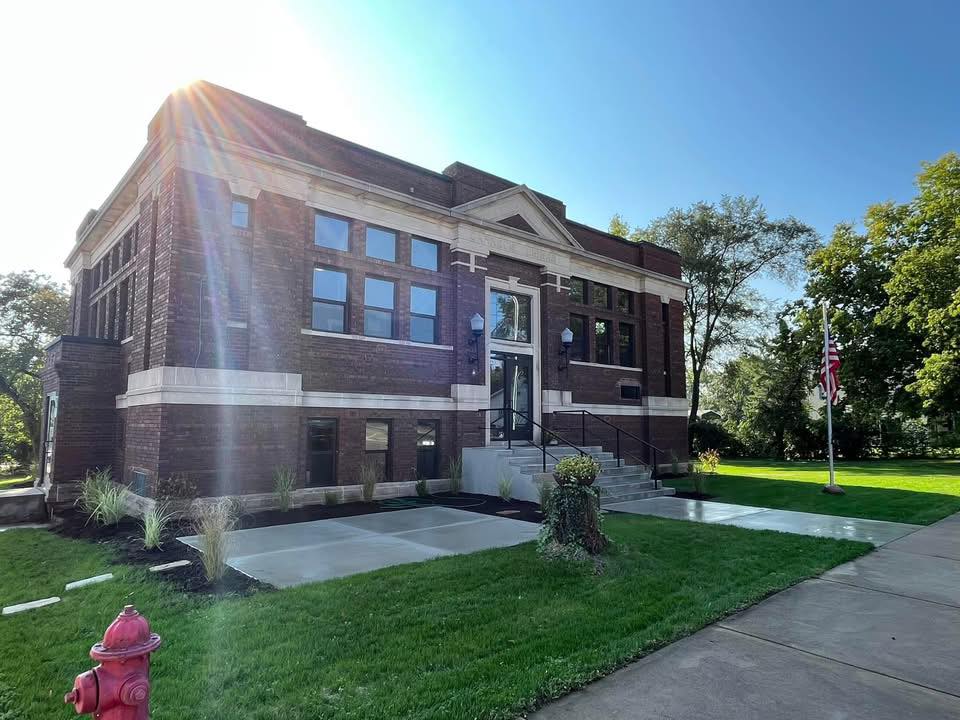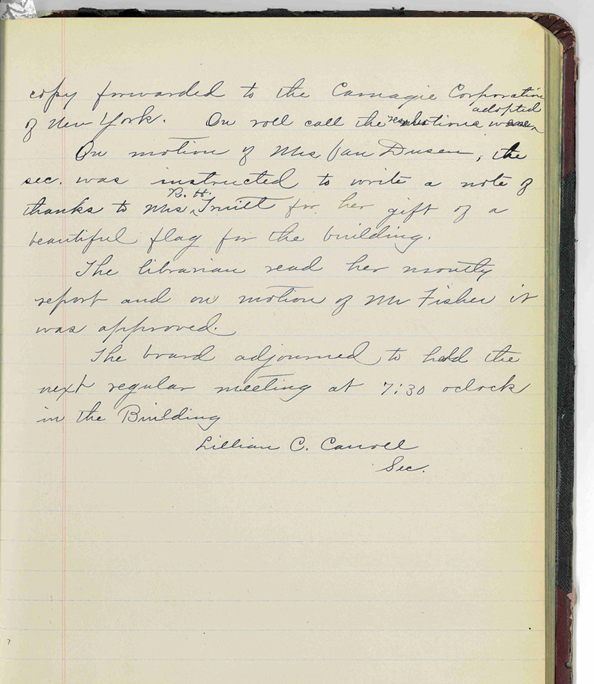The Carnegie Library

The first public library to serve the community of Chillicothe was formed in 1914, and called the Free Public Library. The first meeting date for the board of directors was held on November 3, 1914 (a copy of the original notice is attached), and because there was no formal building (yet) the Trustees met in the office of a “Mr. H.C. Pettett” (who was an attorney).
They had organized with the intent to construct a formal public library to serve the residents of Chillicothe, Illinois.
To meet their aim, one of the first orders of business for the new library board was to find a proper location on which to build. From the official library minutes, a “Mr. Mathews” had proposed the sale of “the west 130 ft. of lot one (1) in block three (3) in the original town, now City of Chillicothe, for the sum of $1,200”. That proposition was accepted unanimously by the Board of Trustees.
That same year, the Board started communicating with the Carnegie Corporation of New York to discuss procuring funds for a library building. They also began correspondences with various architects familiar with the Carnegie Corporation specifications for library buildings. As noted in the minutes “Letters were read from nine architects, from New York City, Chicago, Kansas City, Lafayette, IN, Galesburg, and Peoria.”
On July 21st, 1914, the Board selected “A.W. Morrow of Chicago to be employed as architect and superintendent of construction of the library building…” Subsequently, bids were received in November, 1915, and the proposal for $8,940 by F.L. Boher was accepted.
By August 4, 1916 the first public library of Chillicothe was complete.
A library dedication was held on September 6th, 1916 where members of the public were invited to inspect the “state of the art facility,” which boasted “700 volumes upon the shelves.” (As comparison, the current library has over 35,000 items on our shelves!)
Why did it shut down?
Actually, the library never shut down it simply was moved from the 2nd street location to the current. In 1992, in response to a growing community, the library became a District library, and began developing plans for building the current facility. This building was completed in 2004.
How is the new library better, or different?
While everyone misses the Carnegie, the current building is far better suited for meeting the needs of the community. The 25,000 square foot facility provides ample room for housing materials, hosting programs, providing meeting space, public computers, etc. It was also built to contemporary building standards, including ADA. This makes it accessible to all people regardless of ability – which is an important objective for public libraries in general.
How did the switch of libraries affect the community?
The community fully appreciates the beautiful building that we’re currently in. And while the Carnegie is unique, and amazing in its own right, the issue with those libraries (and there are still many in operation in the U.S. and Europe) is that they were built in such a way that expanding, or updating tends to be either extraordinarily expensive, impossible, or prohibited (if they’re on a historic registry).
The old library is now a hotel!
Yes! And it is a fantastic way to preserve the history of the building. The Carnegie
Is the community better off with the new library?
Without hesitation, yes, the community is better off with the new library. This building was constructed with the future in mind. And that vision allows us flexibility to respond to the changing needs of the community. We are also able to implement sustainability initiatives, like adding rooftop solar, and other energy efficiencies that help educate our community, while saving the library money. Those savings are used to increase our materials, keep current with technology, and offer more public programs.




For more information on Carnegie Libraries, you might enjoy these articles:
Carnegie Libraries: The Future Made Bright (Teaching with Historic Places)
How Andrew Carnegie Turned His Fortune Into A Library Legacy
